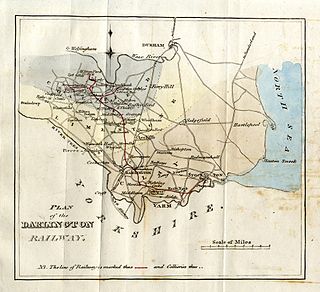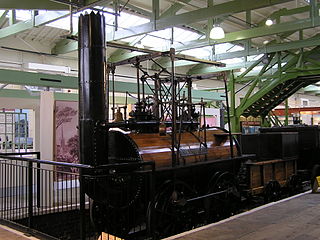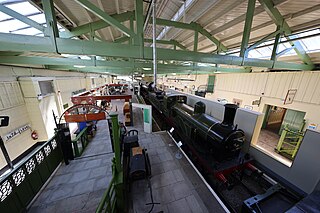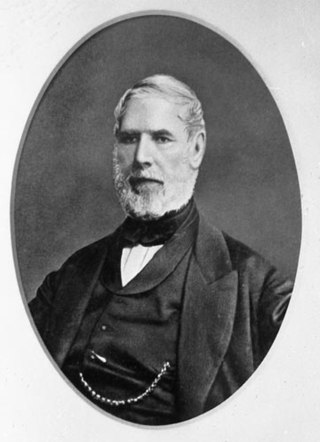Related Research Articles

The Stockton and Darlington Railway (S&DR) was a railway company that operated in north-east England from 1825 to 1863. The world's first public railway to use steam locomotives, its first line connected collieries near Shildon with Darlington and Stockton in County Durham, and was officially opened on 27 September 1825. The movement of coal to ships rapidly became a lucrative business, and the line was soon extended to a new port at Middlesbrough. While coal waggons were hauled by steam locomotives from the start, passengers were carried in coaches drawn by horses until carriages hauled by steam locomotives were introduced in 1833.

Shildon is a town and civil parish in County Durham, in England. The population taken at the 2011 Census was 9,976. The town has the Locomotion Museum, due to it having the first station, built in 1825, and locomotive works on the Stockton and Darlington Railway.
Faverdale is a suburb of Darlington in County Durham, England. It is situated in the north west of Darlington, north of Cockerton. The area was rural until the 20th century, a large wagon works was established in the 1920s, with housing development starting at the same time. The wagon works closed in the 1960s and further industrial and commercial development took place expanding from the brownfield site. As of 2012 the area has a mixture of industrial, residential and rural land use.

Locomotion No. 1 is an early steam locomotive that was built in 1825 by the pioneering railway engineers George and Robert Stephenson at their manufacturing firm, Robert Stephenson and Company. It became the first steam locomotive to haul a passenger-carrying train on a public railway, the Stockton and Darlington Railway (S&DR).

Daniel Adamson was an English engineer who became a successful manufacturer of boilers and was the driving force behind the inception of the Manchester Ship Canal project during the 1880s.

Darlington Works was established in 1863 by the Stockton and Darlington Railway in the town of Darlington in the north east of England. The main part of the works, the North Road Shops was located on the northeast side of the Stockton and Darlington Railway
Robert Stephenson and Company was a locomotive manufacturing company founded in 1823 in Forth Street, Newcastle upon Tyne in England. It was the first company in the world created specifically to build railway engines.
R and W Hawthorn Ltd was a locomotive manufacturer in Newcastle upon Tyne, England, from 1817 until 1885.

Head of Steam, formerly known as the Darlington Railway Centre and Museum, is a railway museum located on the 1825 route of the Stockton and Darlington Railway, which was the world's first steam-powered passenger railway. It is based inside the station building at the North Road railway station. Its exhibits are devoted to the area formerly served by the North Eastern Railway with a particular focus on the Stockton & Darlington Railway and the railway industry of Darlington. In 2022, plans were submitted to expand the museum as part of the Railway Heritage Quarter. In December 2023, the museum temporarily closed its doors to undergo a £35 million redevelopment.

Hopetown Carriage Works, also known as the Stockton and Darlington Railway Carriage Works, was a carriage works of the Stockton and Darlington Railway built in 1853 in Hopetown, near Darlington, County Durham, England.

Derwent is an 0-6-0 steam locomotive built in 1845 by William and Alfred Kitching for the Stockton and Darlington Railway (S&DR). It is preserved at Darlington Railway Centre and Museum, now known as Head of Steam.
William Bouch was an English railway engineer, who is famous for the steam locomotives he designed for the Stockton and Darlington Railway. In 1860, Bouch designed the first British standard gauge locomotives to use a 4-4-0 wheel layout which had earlier become popular in the United States.
Bowesfield Works was a railway locomotive manufacturing plant in Stockton-on-Tees. The works was operated by a joint venture company called Metropolitan Vickers-Beyer Peacock from 1949 until 1960.
James I'Anson Cudworth was an English railway engineer, and was Locomotive Superintendent of the South Eastern Railway (SER). He served in this capacity from 1845 to 1876. He is notable for designing a successful method for burning coal in steam locomotives without significant emission of smoke, and for introducing the 0-4-4T wheel arrangement to English railways.

James Kennedy was a Scottish locomotive and marine engineer. He was born in the village of Gilmerton near Edinburgh, Scotland.
James Fenton (1815–1863) was a Scottish engineer.
Ken Hoole (1916–1988) was an English historian known for his works on the railways of the north east of England.

Tees Marshalling Yard is a railway marshalling yard, used to separate railway wagons, located near Middlesbrough in North Yorkshire, Northern England.

The 1825 to 1863 Stockton and Darlington Railway (S&DR) was the world's first public railway to use steam locomotives. Its first line connected collieries near Shildon with Stockton-on-Tees and Darlington, and was officially opened on 27 September 1825. While coal waggons were hauled by steam locomotives from the start, passengers were carried in coaches drawn by horses until carriages hauled by steam locomotives were introduced in 1833.
References
- 1 2 Sources:
- "Alfred Kitching", www.gracesguide.co.uk, Grace's Guide, retrieved 17 April 2012
- "William Kitching", www.gracesguide.co.uk, Grace's Guide, retrieved 17 April 2012
- "W. and A. Kitching", www.gracesguide.co.uk, Grace's Guide, retrieved 17 April 2012
- 1 2 Sources:
- "British locomotive manufacturers", steamindex.com, Kitching, W. & A., Hope Town Foundry, Darlington
- "Brief Biographies of Major Mechanical Engineers", steamindex.com, Kitching, Alfred & William & family
- ↑ Maurice W. Kirby (1993 [2002]), The Origins of Railway Enterprise, Appendix 2 "Directors and senior salaried officials of the Stockton and Darlington Railway Company, 1825–1962", p.184; see also p.118, 188
- ↑ Maurice W. Kirby (1993 [2002]), The Origins of Railway Enterprise, pp.67, 104–5
- ↑ Sources:
- Chris Lloyd (31 March 2010), "Tracking down the locomotives", www.thenorthernecho.co.uk
- "Darlington Railway Centre & Museum Collecting & Disposals Policy 2006 – 2011", www.darlington.gov.uk, Section 5.5.3
- "Steam locomotive entitled Derwent", www.nrm.ork.uk
- Derwent, Darlington Railway Centre and Museum, archived from the original on 24 March 2008
- ↑ "British locomotive manufacturers", steamindex.com, I'Anson, C. & Co, Hope Town Foundry, Darlington
- ↑ Wood R 'History of Whessoe' (unpublished MSS: 1954) DCRO
- 1 2 3 4 "Company History", www.whessoe.co.uk, Whessoe Projects Ltd., retrieved 17 April 2012
- 1 2 "Whessoe Foundry", www.gracesguide.co.uk, retrieved 17 April 2012
- ↑ "Whessoe", www.gracesguide.co.uk, retrieved 17 April 2012
- 1 2 "Whessoe Varec Europe", www.whessoevarec.com, retrieved 17 April 2012
- ↑ "Growth in Nuclear Reactor Pressure Vessels (advert)". New Scientist. 23 (407). 3 September 1964. ISSN 0262-4079.
- ↑ Whessoe Oil & Gas Ltd Archived 18 October 2010 at the Wayback Machine
- ↑ "History". whessoe.co.uk. Retrieved 28 April 2015.
2013 ... – Whessoe Engineering Ltd Formed Whessoe acquired by Samsung C&T Corporation; offering fully integrated solutions including LNG across the globe.
- ↑ "Construction blacklist". ICO. Retrieved 7 September 2015.